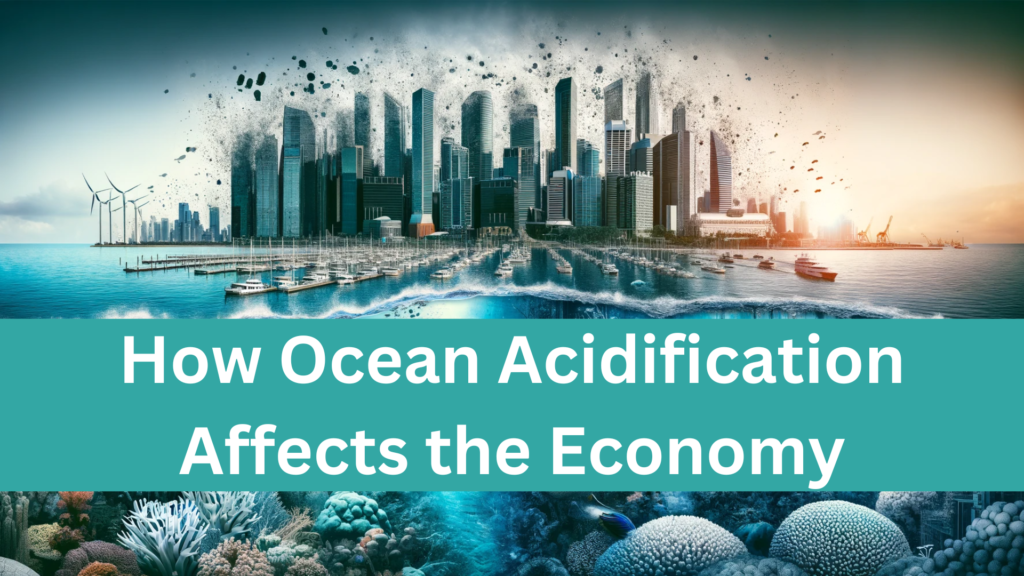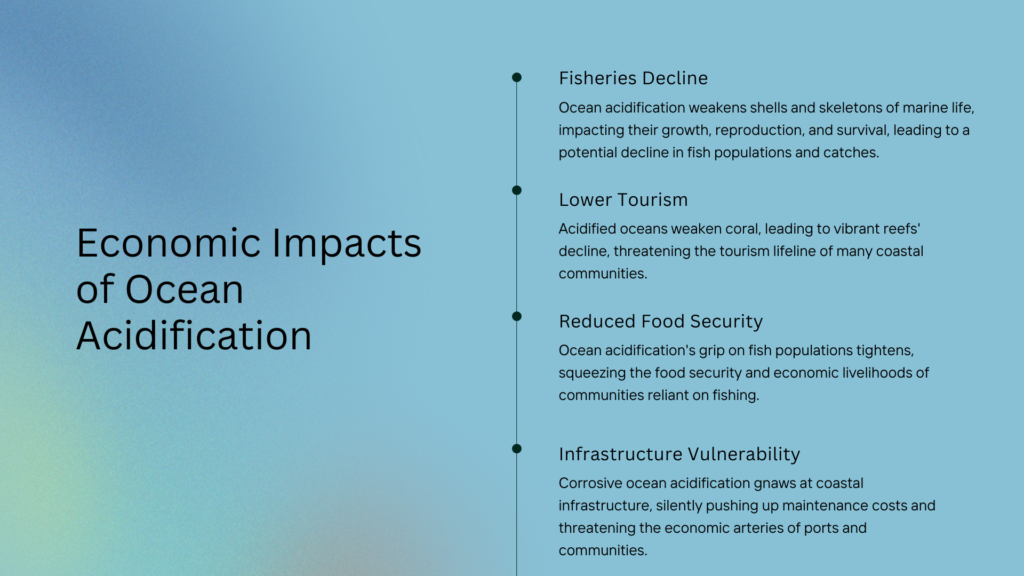
The vast ocean, often viewed as a boundless resource, is facing a silent threat: acidification. Driven by rising atmospheric carbon dioxide, the ocean’s chemistry is subtly shifting, becoming increasingly acidic. While the consequences for marine life are well-documented, the ripple effects on our economy deserve urgent attention.
In this article, we will delve into the ways ocean acidification affects the economy, focusing on two key economic risks. Additionally, we will discuss potential solutions to mitigate these risks.
Background information: Ocean Acidification at a Glance: Ocean Acidification Infographic

1. Decline in Fisheries
Ocean acidification profoundly impacts fisheries, posing severe risks to food security and economic stability. This section delves into the details:
Shellfish Vulnerability: Acidic waters inhibit the ability of shellfish like oysters, mussels, and clams to build protective shells, leading to a decline in shellfish populations. This not only impacts the seafood industry but also threatens a critical source of protein for millions worldwide. Other seafood species, like salmon, are also impacted.
Coral Reefs at Risk: Coral reefs, vital ecosystems, serve as nurseries for marine species, attracting both tourists and fishermen. As ocean acidification deteriorates coral health, it affects fisheries and the marine food chain as a whole, jeopardizing food security and economic livelihoods.
Marine Food Chain Disruption: Ocean acidification impacts microorganisms at the base of the food chain, which has far-reaching impacts, including cascading effects on fisheries as predator-prey relationships shift and fish populations are affected.
Global Consequences: The economic repercussions ripple across the globe. For instance, the Pacific Northwest of the United States, heavily reliant on shellfish aquaculture, is already experiencing significant financial losses due to declining shellfish yields.
Studies estimate global losses in shellfish harvest could reach $480 million annually by the end of the century.
2. Impacts on Tourism
The tourism sector in coastal regions is susceptible to the pervasive effects of ocean acidification, further undermining economic stability:
Declining Attractiveness: Iconic coastal destinations, known for their pristine waters and vibrant marine life, are losing their appeal as ocean acidification damages coral reefs and disrupts underwater ecosystems.
Revenue Reduction: Tourism-related businesses, including hotels, restaurants, and tour operators, suffer from reduced revenues as visitors seek alternative destinations. This results in job losses and economic hardship in affected communities.
No More Wildlife Tours: Coral reefs, once vibrant and full of life, are now threatened, leading to a reduction in biodiversity-related tours. Tourists are increasingly looking for alternative destinations, leaving a lasting impact on the economic sustainability of coastal regions.
Other Effects of Ocean Acidification on the Economy
While a decline in fisheries and tourism revenue are the two key economic risks posed by ocean acidification, acidification is having other major impacts as well, many of which have economic consequences.
Reduced Food Security
Ocean acidification also has a direct bearing on global food security, particularly for communities heavily dependent on seafood:
Nutrient Disruption: Acidic oceans disrupt nutrient availability for marine life. This can lead to altered marine food webs, affecting the abundance and distribution of fish species that are vital for global food security.
Decreased Harvests: Diminished fisheries due to ocean acidification translate to decreased seafood harvests, which can strain the availability of affordable and nutritious protein sources for vulnerable populations.
Infrastructure Vulnerability
Ocean acidification has indirect consequences for infrastructure, as coastal communities face heightened risks from rising sea levels and extreme weather events:
Coastal Erosion: Weakened coral reefs and the degradation of coastal ecosystems due to ocean acidification contribute to coastal erosion, putting infrastructure such as roads, buildings, and utilities at risk. While less visible, acidified seawater can even corrode coastal infrastructure like docks, piers, and seawalls. This increases maintenance costs and can eventually lead to structural damage, impacting ports, transportation, and coastal communities.
Increased Maintenance Costs: Infrastructure in coastal areas must contend with more frequent and severe damage, increasing maintenance costs for governments and businesses.
Solutions to Economic Effects of Ocean Acidification
Addressing both the direct and indirect economic risks of ocean acidification requires a holistic approach:
Reducing Carbon Emissions: Mitigating the root cause of ocean acidification involves reducing carbon emissions. Transitioning to renewable energy sources, enhancing energy efficiency, and promoting sustainable transportation are key steps. New projects are also working to remove carbon dioxide from the ocean.
Sustainable Practices: Implementing sustainable fishing practices, such as catch limits and protected marine areas, can help preserve fish populations and protect the livelihoods of fishermen.
Coral Reef Restoration: Investing in coral reef restoration efforts can aid in revitalizing tourism and fisheries. This includes coral transplantation and monitoring programs.
Diversification: Coastal communities should explore diversification strategies beyond fisheries and tourism, including aquaculture and alternative livelihoods, to reduce their vulnerability to the impacts of ocean acidification.
Infrastructure Resilience: Governments and communities must invest in resilient infrastructure to withstand the challenges posed by ocean acidification, including sea-level rise and extreme weather events.
Ocean acidification’s far-reaching effects on the economy are undeniable. The decline in fisheries, tourism, and its impact on coastal communities underscore the urgency of addressing this issue. By reducing carbon emissions and implementing sustainable practices, we can mitigate economic risks, safeguard food security, and protect critical infrastructure, promoting a healthier, more secure global society.